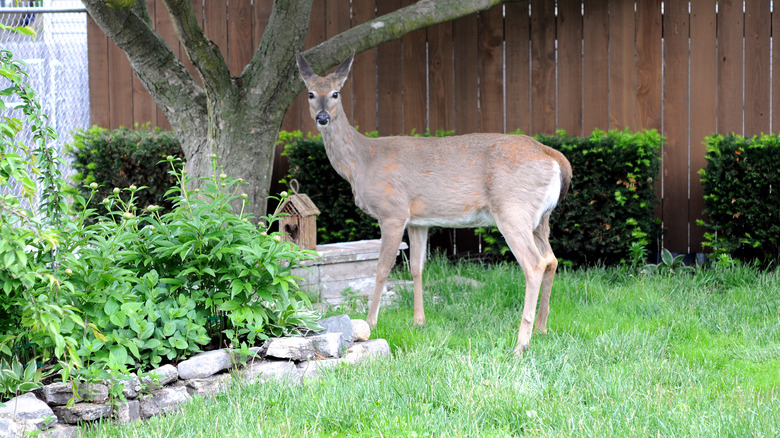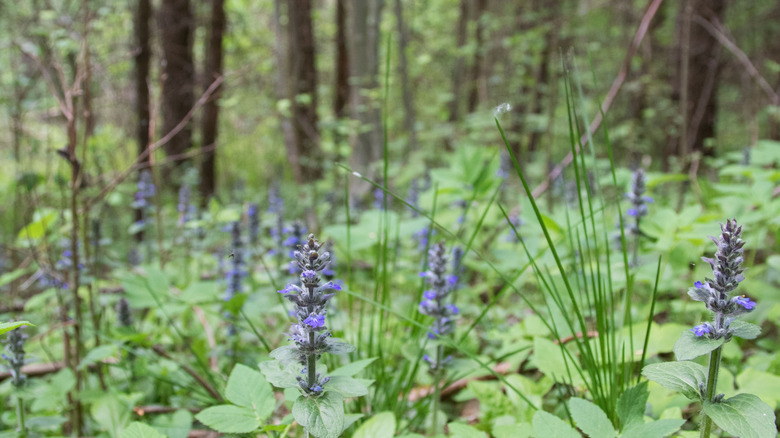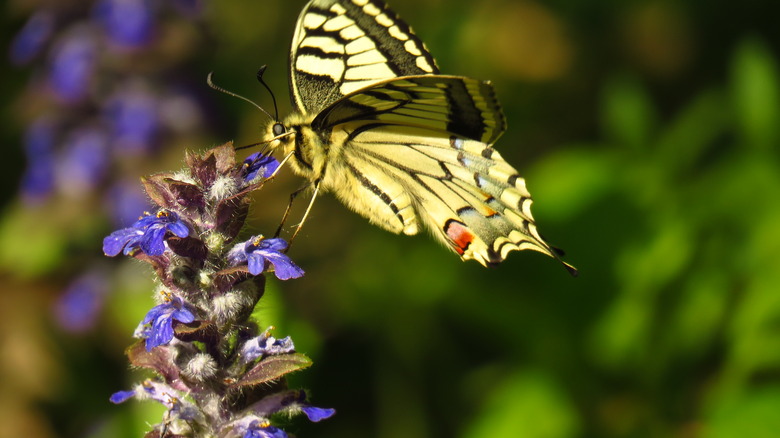The Hardy Ground Cover That's Deer-Resistant And Will Choke Out Weeds
We may receive a commission on purchases made from links.
Would you consider yourself a lazy gardener? By that, we mean someone who wants to enjoy all the benefits of abundant greenery for as little effort as possible. There's a plant out there that thrives with little care, is hated by exoskeletal and fur-covered pests, doesn't mind being stepped on, smothers weeds, and even has colorful foliage that attracts pollinators, beneficial insects, and hummingbirds. Savvy green thumbs — amateur and experienced alike — may have already guessed that we're talking about bugleweed.
Bugleweed (Ajuga reptans) is an evergreen groundcover that goes by a few other names: bugle, common bugleweed, carpet bugleweed, carpet bugle, carpetweed, blue bugle, bugleherb, and ajuga. It was brought to the U.S. by early European colonists who favored it as a medicinal herb (though that's no longer recommended). Now, it's naturalized in the eastern United States and parts of the Northwest and is easy to grow in most USDA Hardiness Zones — from 3 to 9. The numerous cultivars boast leaves ranging from lime green to deep purple with blue, violet, white, or pink flowers that bloom from early spring well into the summer.
The benefits
It's for good reason that bugleweed gets an A (Rarely Damaged) on Rutgers' Deer Resistant Landscape Plants list. While bugleweed isn't toxic, it's packed full of bitter compounds — aucubine, iridoids, flavonoids, polyphenols, and tannins, to name a few — that make it decidedly untasty to mammalian palates. Typically, deer avoid it, and so do rabbits. As with all plants, the deer resistance label only goes so far; deer (and other herbivores) may still browse the plant during the winter (especially young plants) when preferred food sources are scarce. Muskrats are an exception; they like to eat bugleweed roots.
Bugleweed thrives in difficult places — unfertile, partially shady, rocky, foot-trafficked areas of your yard. Are you having trouble finding plants to go under your walnut or Norway maple trees? Bugleweed is immune to the chemical deterrents these plants put out. If your garden is plagued by unwelcome weeds, plant bugleweed. The plant has special roots called stolons that spread outwards from the mother plant underground. Seedlings sprout from the stolons, clones that emerge aboveground to establish new plants. It'll quickly crowd out the unwanted plants (read: weeds) and look good doing it. What's more, the hardy roots help stabilize at-risk banks and slopes, and it's a friendly option for your lawn, doing well in shady spots where traditional lawn grass fails to grow.
Growing bugleweed
As mentioned above, plant bugleweed under trees and in shadier spots in your garden or where you want to crowd out weeds. Beware: It may lose its leaf color if grown in full shade and can also outcompete wanted but less aggressive plants if growth gets too vigorous. Given its deer-deterrent attributes, you can grow bugleweed along deer fences to further discourage hungry mammals. While bugleweed doesn't mind being walked on, it won't do well as a pathway groundcover — think of it more as a lawn replacement in less-visited areas of your yard. The plant is an excellent addition to a pollinator, beneficial insect, or birdwatcher's garden since it boasts spring-summer nectar-filled blooms attracting butterflies, bees, ladybugs, and hummingbirds.
There are lots of cultivars of bugleweed, each favored for different attributes, such as leaf color, bloom hue, hardiness, or spreadability. Plant Delights Nursery in Raleigh, NC, has 3.5-inch pots of Ajuga reptans "Texas Tough" for $18. Get 10 4-inch pint pots of the undeniably pretty Burgundy Glow Ajuga for $69.27 from Wilson Bros Garden. Visit Walmart for Chocolate Chip Ajuga with miniature leaves (48 plants in 1.75-inch pots) for $34.99. Bugleweed is easily propagated from cuttings, too. If any keen gardeners in your area have the plant in their yard, ask for a cutting with the stolon attached. Plant it directly into your garden or grow it bigger in a pot first.


